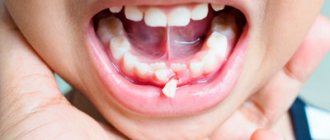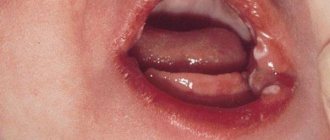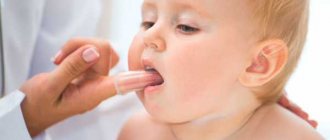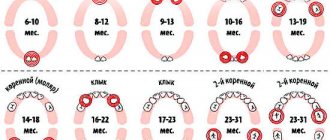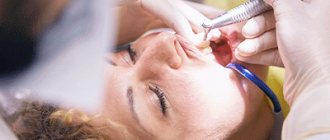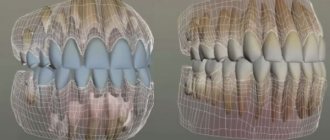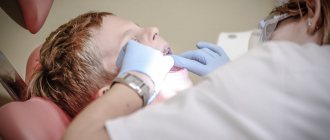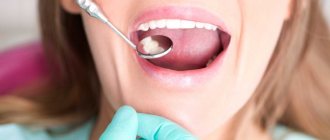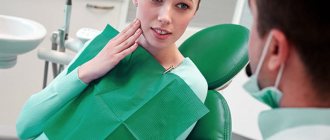Date of publication: 04/04/2016
until February 28
You get 10% cashback when purchasing a gift certificate More details All promotions
If a child begins to behave restlessly, sleep poorly at night, sulk and be capricious, this does not always mean that he is sick. Maybe he's just teething.
Erupting teeth irritate the nerve endings in the gums, which explains changes in the baby’s behavior. The child puts everything into his mouth, feeling the need to bite and gnaw - this makes it easier for him to tolerate the itching of the gums. The gums turn red and swell. At this time, saliva is released abundantly; it simply flows from the child’s mouth. In some cases, diarrhea (diarrhea) and fever may occur.
Teething
– a serious event for the body that requires effort. As a result, immunity may decrease, which creates a favorable situation for various infections to enter the body. Therefore, during this period it is especially important to monitor the health of your baby.
What to do if teeth do not erupt “on time”?
Nothing to do. As stated earlier, the timing is quite relative and not strict data. There is such a thing as the individual characteristics of a child. Plus neonatal indicators, physical constitution, etc. Thus, the timing of the appearance of teeth in your child is normal for him. The same applies to permanent teeth.
The later the teeth appear, the healthier they will be?
Is not a fact. The timing of teething does not affect their “quality”.
What sedatives can be used during teething? Do they influence the process itself?
No, such drugs do not affect the process of teeth formation and, as a rule, have no side effects. For children with allergies, there is a sedative called Doctor Baby that does not contain lidocaine. Almost all gels contain lidocaine and inert fillers (cooling menthol, astringents and flavoring additives). You can use Dentinox, Kalgel (be careful with diathesis, because it is sweet), Kamistad (very effective, but you need to know when to stop), Mundizal, Cholisal, Solcoseryl dental paste (especially good in the presence of wounds or ulcers).
How often should such drugs be used?
Soothing gels are not antibiotics and do not need to be used according to a specific regimen. If the child is in pain, apply it, but if everything is calm, don’t. But it’s better not to use it more than 3-4 times a day and for longer than 3 days in a row.
What parents should pay attention to
In order to reduce the likelihood of difficult eruption of wisdom teeth, parents should monitor the condition of the dental system in children from a very early age. The key to normal jaw development is breastfeeding, which involves the entire musculature of the maxillofacial area.
To prevent jaw deformities from forming, it is necessary:
- Wean your child off pacifiers.
- Fight bad habits such as sucking fingers and toys, biting your lip or cheek.
- Prevent rickets, which negatively affects the structure of the jaws.
- Make sure to maintain nasal breathing, since when breathing with an open mouth, the child’s lower jaw lags behind in development.
- Change the child's position while he sleeps.
- Treat teeth in a timely manner, preventing the development of inflammatory processes in the jaw bones.
- Regularly conduct preventive dental examinations with pediatric dentists.
These measures will remove barriers to jaws reaching their natural size, ensuring wisdom teeth have their rightful place in the dentition. If a teenager has troubles when cutting through the “eight”, he should immediately contact a dental surgeon, who will determine the final fate of the insidious tooth.
The specialists of the Shifa clinic are always ready to provide qualified assistance in both preventive and therapeutic areas. Our center employs doctors specializing in pediatric dentistry. We find an approach to every child.
Is it possible to speed up teething?
Medication - no. But massaging your gums won't hurt at all. Using a clean finger, gently and gently massage your baby's gums. The baby will feel better, and the tooth will cut through faster. Just do not press hard so as not to injure the gums. You can give your child a cool spoon or pacifier to hold in his mouth. Try buying special teethers with liquid. They are placed in the refrigerator for a while, and then given to the child to chew on. All these methods are good in moderation, do not overdo it.
Can bad breath occur during teething and what is the cause?
The process of teething is associated with partial decomposition (lysis) of the mucous membrane under the action of salivary enzymes. We all notice that the amount of saliva increases sharply during this period. In this case, indeed, indicators such as viscosity, color and smell of saliva may change. Another factor is the presence of weak antibacterial substances in saliva, which are designed to prevent infection of the wound when a tooth cuts through the gum. A certain amount of blood also enters the oral cavity. When it decomposes, a sour (metallic) odor may appear.
A sharp increase in temperature during teething. What to do?
Teething does not cause a temperature jump to 39-40 degrees. Only a slight increase is possible, which is normal. Be careful: teething should not cause high fever, diarrhea, vomiting, complete loss of appetite, cramps or choking. If you have such symptoms, even if you attribute it to your teeth, consult a doctor. It is also not recommended to use antipyretics and painkillers without consulting him.
What is the difference between an increase in temperature due to teething and an increase due to other reasons? How long can the elevated temperature last in the first case?
It all depends on the individual characteristics of the child. Basically, hyperthermia and diarrhea are only secondary signs of the teething process, which in itself is a serious physiological turning point for a small organism. Fever is, rather, a reaction to inflammation of the oral mucosa. After all, at the site where the tooth exits, irritation forms, often a wound that can become infected. Thus, hyperthermia is caused not by the mechanism of tooth formation itself, but by side effects. After all, the eruption of permanent teeth, despite the similarity of histological and physiological changes, causes symptoms of colds and diarrhea extremely rarely. And it is quite simple to explain their appearance in children: changes in diet and diet, constant foreign objects in the mouth, microflora disturbance, weakened immunity in the nasopharynx. So, if high fever and loose stools continue for more than 72 hours, then teething really has nothing to do with it.
Problems
According to statistics, four out of five people experience complications during the eruption of wisdom teeth. They can be very diverse:
- Anomalies in size and shape that make their removal an unpredictable process.
- Undetermined number of roots.
- Dystopia is the appearance of a tooth outside the dental arch.
- Significant deviation from the vertical axis.
- Displacement of the remaining teeth, causing crowding in the anterior region and malocclusion.
- Neoplastic processes associated with the preservation of the follicle membrane.
- Inflammatory processes as a consequence of difficult eruption:
- pericoronitis (pericoronitis) - inflammation of the mucous membrane covering the chewing surface of the figure eight with the so-called hood;
- periostitis - inflammation of the periosteum (in everyday life called “flux”);
- osteomyelitis - purulent inflammation in the bone;
- abscess - an abscess in soft tissues;
- phlegmon is a diffuse purulent inflammation of soft tissues.
Often wisdom teeth are not sufficiently mineralized and are therefore susceptible to caries.
Teething in infants
Possible characteristics of teeth in children at the teething stage. Stay up to date.
The expansion of the spaces between the teeth is caused by the growth of the jaws. During the transition from baby teeth to permanent teeth, it is considered a normal condition. A wide gap between the upper anterior incisors is usually associated with a deep-lying maxillary frenulum. An orthodontist should observe and treat such a gap between the teeth;
- a blackish edging on the neck of the tooth can form when taking soluble iron supplements, as well as during a chronic inflammatory process (precipitation of bacteria from the leptotrichium group);
- yellowish-brown staining of teeth may be associated with the use of antibiotics - by the mother in the 2nd half of pregnancy or by the child himself during the formation of teeth;
- yellowish-greenish coloring is caused by severe disturbances in bilirubin metabolism, hemolytic conditions (destruction of red blood cells);
- reddish staining of tooth enamel is characteristic of a disease called porphyria - a congenital disorder of the metabolism of porphyrin pigment;
- malocclusions are formed by the uneven growth of the child’s jaws, as well as prolonged sucking of the nipples;
- Anomalies in the location of teeth occur for a number of reasons: trauma, congenital disorders of connective tissue metabolism, constitutional reasons (small jaw size), tumors of the alveolar process of the jaw.
- the absence of teeth before one year of age is extremely rarely associated with edentia (lack of tooth buds), which can be checked using radiovisiography as prescribed by a pediatric dentist.
If teeth erupt on time and in a certain order, this indicates the normal development of the child’s body. After all, this physiological process is in direct connection with the general health of the baby. Some atypical cases may indirectly indicate the presence of pathology. But only a special examination of the child can confirm or refute the assumptions made. The reasons must be identified and analyzed by a specialist.
Wisdom teeth
X-ray images convincingly prove that at the time of birth, the child’s jaw contains two rows of complete sets of the rudiments of milk and permanent teeth in different stages of formation. The smallest translucent “vesicle follicles” located at the end of the rows are the future wisdom teeth.
A baby's jaws are small. They only accommodate 5 primary teeth on each side of the midline. As the jaw grows, a free space is formed behind the outer teeth, in which the first permanent molar, the “six” and then the “seven,” erupts. At this time, the wisdom tooth very slowly goes through the stages of formation and mineralization.
Complete ossification of the jaw ends by 15-16 years. And it often turns out that there is not enough space for a wisdom tooth on the alveolar process. In 25% of cases, fully formed “eights” remain hidden in the bone. Then they talk about their retention.
Disruption of growth periods
If teeth have not erupted within the specified time frame, it is still worth contacting a dentist. The doctor, after conducting a visual examination, X-ray diagnostics (will allow you to determine the condition of the tooth buds), and collecting a complete anamnesis, will be able to give an opinion as to what caused the growth retardation.
It is possible that referrals will be given to see other specialists, the necessary medications will be prescribed, and nutritional adjustments will be required.
In any case, the main role in delayed dental growth is played by the general development of the body and past diseases.
What affects the timing of teeth appearance?
Each child goes through his own developmental path. There are no standards here. Several factors influence teething:
- Heredity. If your baby's teeth are growing poorly and slowly, perhaps his mom and dad had the same thing. There is no need to worry here.
- The course of pregnancy and intrauterine development. It is known that the rudiments of baby teeth are formed in the seventh week of pregnancy, and permanent teeth in the fifth month.
- Child nutrition. The baby's complementary foods should be rich in minerals, including calcium. Poor and unbalanced nutrition worsens this process.
Dentists advise: to strengthen gums and grow children's teeth, vitamins are needed (the main ones are A and D). They are found in sufficient quantities in fermented milk products, vegetables and fruits.
- Past illnesses. Rickets, especially severe forms, hypofunction of the thyroid gland, exudative diathesis and other diseases affect delayed teething.
- Natural factors (proximity to nuclear test sites, fluoride pollution of the environment and much more).
- Dental anomalies.
Pediatric dentistry specialists have nevertheless drawn up a diagram of the growth of incisors, canines and molars, although the sequence of their appearance and timing are approximate:
- 6-10 months – upper central incisors;
- 8-12 months – lower central incisors;
- 10-16 months – lateral incisors;
- 1.5-2 years – fangs;
- 1-1.5 years – first molars;
- after 2 years – second molars.
Take note: to prevent the baby tooth from interfering with the growth of the permanent one, you can ask the child to pull it out himself. If it's already very wobbly, it won't hurt. And replacing a tooth hidden under a pillow with candy will be a joyful surprise for the baby.
The change to permanent teeth begins at the age of 5-7 years. First the incisors fall out, then the fangs. The matter is completed by replacing the first and second molars from the center.
The order of eruption of permanent teeth
At the age of 5-6 years, the replacement of baby teeth with permanent teeth begins.
This is preceded by the growth of the rudiments of permanent teeth and the physiological resorption of the roots of milk teeth. As the roots of the teeth are reabsorbed, mobility of these teeth appears. Children often swing their baby teeth on their own. The first permanent molars behind the last primary tooth (deciduous molar) are usually the first to erupt. Their appearance often goes unnoticed: the teeth erupt behind the milk teeth and their appearance is not accompanied by the loss of milk teeth. Closer to 6 years of age, permanent incisors replace primary incisors. First, the primary incisors on the lower jaw are replaced, and then on the upper jaw. At 7 - 8 years old, permanent lateral incisors begin to erupt on the lower jaw, and at 8 - 9 years old - on the upper jaw.
The formation of the roots of young permanent teeth is completed by 10–11 years.
